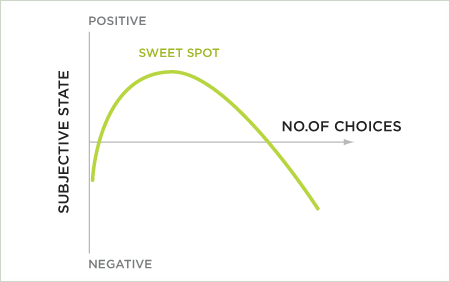Medspa Training: The Paradox of Choice.
/ Too many options create unsatisfied patients.
Too many options create unsatisfied patients.
While the comments below were made regarding web site development, they are equally applicable to any offering. Novice businesses often want to include the 'we do it all' statements in their advertising and consultations, in effect, putting the decision making problems back in the lap of the patient.
The patient wants and needs to feel secure in their decision. Creating a menu of too many choices creates a petrie dish of patient dissatisfaction.
From the patients point of view, too many choices puts them at risk of choosing something other that the optimal. While you may not want to extend yourself to 'telling a patient what to choose', that's exactly what the patient wants you to do. Great salesmen know this and often employ a 'shark fin' approach by narrowing the offering to three choices; an exceptionally expensive choice, a minimal baseline choice, and the one they're really selling, the 'as good as premium but without the bells and whistles choice'.
The patient wants to be sold. That does not mean the the patient wants to be pressured, it means that they want you to lay out their options, risks, and rewards, and make a recommendation in their best interest.
Luke Wroblewski - The Paradox of Choice:
When people have no choice, life is miserable. As you start adding options, you increase wellbeing. However, you reach a point where the curve flattens out and there are diminishing marginal effects. At a point in the curve, satisfaction drops and you are worse off than when you were neutral.
Are all these choices a good thing? Yes. Having choices is good but we have always thought it was only good. There is a dark side as well:
- Paralysis: so many options that you end up not making a choice. A grocery store alternated allowing customers to sample 24 different flavors of jam & 6 different flavors of jam. With 24, more people came to the table but 1/10th as many people bought jam. In Speed dating, you are more likely to select a match with 6 dates vs. 10. For every 10 mutual funds made available, rate of participation in 401(k) investing goes down 2%
- Decision Quality: when presented with too many options, we do not use difficult criteria to decide but choose on the basis of what is most simple. For 401(k)’s the simplest choice is the worst choice: putting money in a money market account. In retail brand and price are the simplest choices.
- Decision Satisfaction: Even when people have chosen well, they are dissatisfied with their results. When you give people lots of options, they will get a better result. But they will feel worse due to regret and anticipated regret. If you did not examine ALL options, you assume one or more might have been better. This reflects opportunity costs: the reduction of value through comparison to other options.
- Escalation of expectations: the availability of many choices increases expectations. When things were worse (less choices): it was easier to exceed expectations (now as high as possible). There are no pleasant surprises left.
- Maximizer Impact: too many choices is an issue for people whose aim in life is to get the best (maximizers). How do you know if you got the best? You actually need to look at every possibility by making an exhaustive search. There is virtually no area where maximizing makes sense.
- Leakage: the conditions present when people are making a choice do not stop exerting influence after a choice has been made. People are less satisfied due to regret or missed opportunities and this dissatisfaction extends after the choice to the actual experience.






